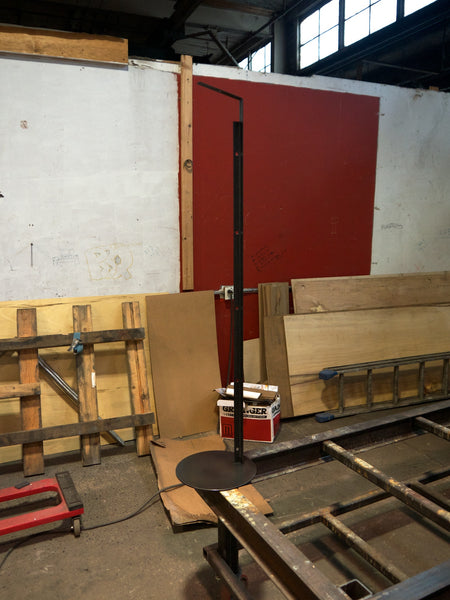Making Graypants lamps
TMAP has been making the metal bases for Graypants' TILT table lamps. Today I finished the first floor lamp base in an attempt to earn the work for their floor lamps.
I thought it would be nice to share the process, so people can see the kind of work I do.

The floor lamp design calls for 1 1/4" x 1 1/4" x 1/8" angle, which I cut to length. This photo shows the coping work done to allow for the bend at the top of the lamp. Detail work here is very important.

I drill all the holes where they need to go, and then tap the two holes for the M6 knurled thumbscrews by hand to ensure they're sharp and perpendicular to the material.

The Hossfeld bender we have at Metalworks & Design is a miracle. It comes with dozens of dies and has worked extremely well for over fifty years.

Bending is a challenge. Slight variations in the material can result in slightly over- or under-bent results.

A little bit of gentle cold forging over Jonathan's anvil horn to spread it back out.

Now the angle's good, so I move on to the base.

Angle grinding is more like painting than like hammering. A gentle touch is required to smooth out the rough edges. Pressing too hard will dig into the material and potentially ruin the piece. The sparks are awesome, but while you're working you have to focus on where the abrasive just was, and think about where your hands should be.

A pneumatic orbital sander polishes the top layer, removing any dirt or small scratches and imparts a random texture which will take the finish well.

Now that each piece is finished, they're joined with a plug weld on the bottom. The fitting is so precise that I have to tap the vertical into the base with a hammer.
When these two pieces are together, the lamp is in its final shape. This is when the finisher uses a remarkable level of attention to detail to give a final touch to the entire lamp.

I am amazed by my finisher's work. Having attempted to do similar work, I can't tell you how much skill it takes to get the results he gets. I can't tell you because I'm not even close.

In this condition it's delivered to Graypants to see if it suits their expectations and wins TMAP the work.
